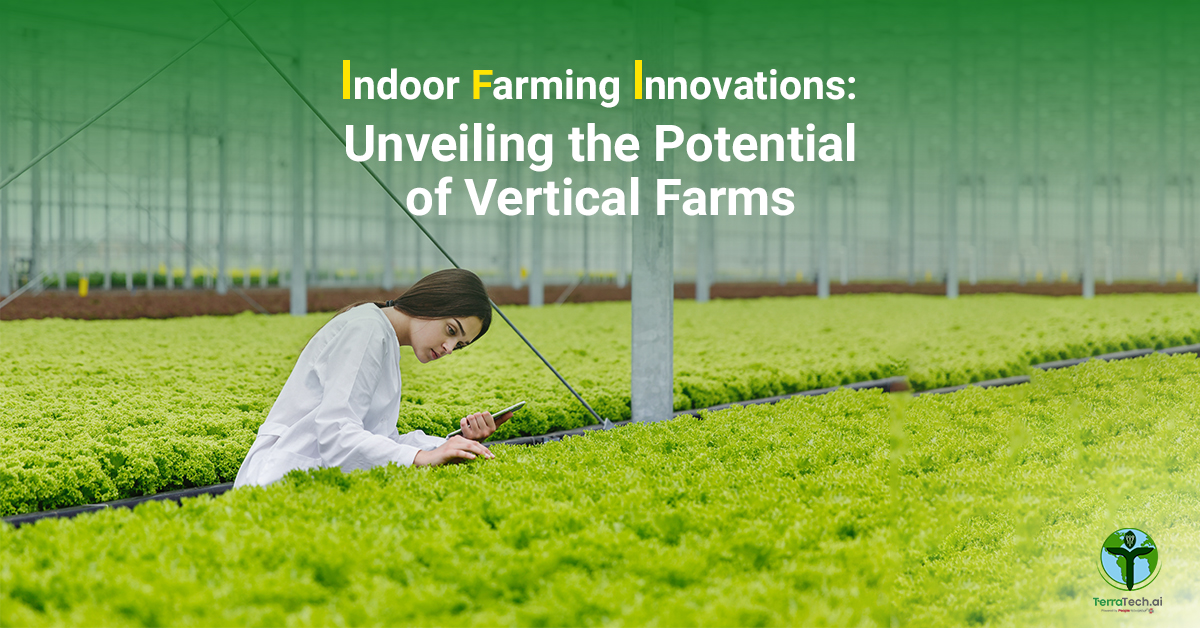Indoor Farming Innovations: Unveiling the Potential of Vertical Farms
In recent years, agriculture has undergone a remarkable transformation with the rise of indoor farming. By leveraging innovative technologies and sustainable practices, indoor farming offers a promising solution to challenges faced by traditional agriculture. Among the various forms of indoor farming, vertical farming technology has emerged as a game-changer.
Vertical Farming Technology – Pioneering the Future of Agriculture
Cultivating crops in greenhouses or vertical farming systems is called indoor farming or controlled-environment agriculture (CEA). Unlike traditional farming methods that rely on sunlight and soil, indoor farming utilizes artificial lighting, various vertical farming systems, and advanced climate control systems to create optimal growing conditions. This technology-driven approach allows for year-round production, regardless of external weather conditions.
A subset of indoor farming, vertical farming technology involves the cultivation of crops in vertically stacked layers of shelves. By expanding farming vertically, this method optimizes the utilization of limited space.
Vertical Farming Benefits
- Efficient Use of Space – Vertical farming systems present a practical solution as the global population rapidly grows and arable land diminishes. The efficiency of utilizing vertical space allows for the cultivation of crops in urban areas, thus improving food security.
- Reduced Water Usage – Water scarcity is a critical global issue, especially in drought-prone regions. Vertical farming technology employs advanced hydroponic or aeroponic systems, which utilize water more efficiently than traditional soil-based farming.
- Year-round Production – Vertical farms overcome the limitations of seasonal agriculture. Year-round crop cultivation is made possible by controlling environmental factors such as temperature, humidity, and light. This ensures a consistent supply of fresh produce regardless of the seasons.
- Reduced Environmental Impact – Traditional farming often contributes to deforestation, soil degradation, and pollution. Vertical farms employ sustainable farming practices by eliminating the need for pesticides, reducing the risk of soil erosion, and minimizing water runoff.
Technological Advancements in Vertical Farming
Vertical Farming Systems
Three primary vertical farming systems have emerged as pillars of indoor agriculture.
- Aeroponics: Aeroponic systems suspend plant roots in the air and mist them with nutrient-rich solutions. This approach facilitates direct nutrient delivery to the roots. This helps in accelerated growth and minimizing water usage.
- Hydroponics: Hydroponic systems involve growing plants in nutrient-rich water without soil. This eliminates the need for land use and conserves water. Hydroponics allows for precise control over nutrient delivery and pH levels to optimize plant growth and minimize resource usage.
- Aquaponics: Aquaponic systems combine hydroponics with fish farming. The fish waste serves as a nutrient source for plants, and in turn, the plants filter and purify the water for the fish. This symbiotic relationship maximizes resource usage and enhances sustainability.
Automated Climate Control & Monitoring
Vertical farming systems employ climate control systems to cultivate plants under optimal growing conditions. These systems monitor and adjust temperature, humidity, CO2 levels, and lighting to optimize plant growth and crop quality. Sensors and advanced algorithms ensure precise control, maintaining optimal environmental conditions and minimizing energy consumption.
Automated monitoring systems constantly collect data on plant health, nutrient levels, and environmental parameters. This real time information enables growers to make data-driven decisions, detect anomalies, and address issues promptly. By monitoring and fine-tuning environmental conditions vertical farms achieve consistent and optimal crop production throughout the year.
Robotics & Automation in Vertical Farming Technology
Robotics and automation play a crucial role in streamlining operations and maximizing efficiency by performing tasks like seeding, harvesting, and plant maintenance. These machines operate with precision minimizing labor requirements, human errors and enhancing productivity.
Automated systems efficiently transport crops, package harvested produce, and perform quality control checks. Vertical farms enhance resource allocation and productivity by automating labor-intensive and repetitive tasks.
Integration of Artificial Intelligence (AI)
AI algorithms analyze vast amounts of data collected from sensors, cameras, and monitoring systems. This data-driven approach enables growers to optimize crop growth by predicting plant behaviour, identifying patterns, and making real time informed decisions.
AI-powered systems can also optimize resource usage by dynamically adjusting lighting, irrigation, and nutrient delivery based on plant needs. By learning from historical data and continuously adapting, AI algorithms enhance efficiency, reduce waste, and improve overall crop quality in vertical farming.
Innovative Applications of Vertical Farms
Urban Agriculture & Food Security
As the global population grows, traditional farming struggles to meet the growing demand for fresh, locally-grown produce. Vertical farms offer a solution by bringing food production closer to urban centers. This minimizes the carbon footprint associated with long-haul food distribution. Vertical farms promote food security, self-sufficiency, and reduced reliance on imported goods by empowering communities to cultivate their own food locally, irrespective of seasonal constraints.
Sustainable & Controlled Environments
Unlike traditional farms, which are subject to unpredictable weather conditions and external factors, vertical farming technology allows precise control over various growth parameters. Vertical farms mitigate the risks of soil erosion and contamination by eliminating the requirement for soil. Moreover, vertical farms minimize water runoff and nutrient leaching, preventing pollution of water bodies and preserving natural ecosystems.
Specialty Crop Production
Vertical farms offer an ideal environment for cultivating specialty crops, including exotic fruits, herbs, and edible flowers that are otherwise challenging to grow in traditional settings. These crops require specific growing conditions, precise temperature, humidity control, and optimized lighting. Vertical farms tailor these conditions to suit the unique needs of specialty crops, allowing farmers to cater to niche markets.
Conclusion
Vertical farming has emerged as a remarkable innovation within the realm of agriculture. By bringing food production closer to urban areas, vertical farming systems address food-security issues, reducing reliance on long-distance transportation and providing a consistent supply of fresh-produce year-round.
As we embrace the potential of vertical farms, we can envision a future where agriculture is sustainable. Together, let’s pave the way for more sustainable farming practices and a resilient agricultural landscape, ensuring a brighter future for generations to come.

